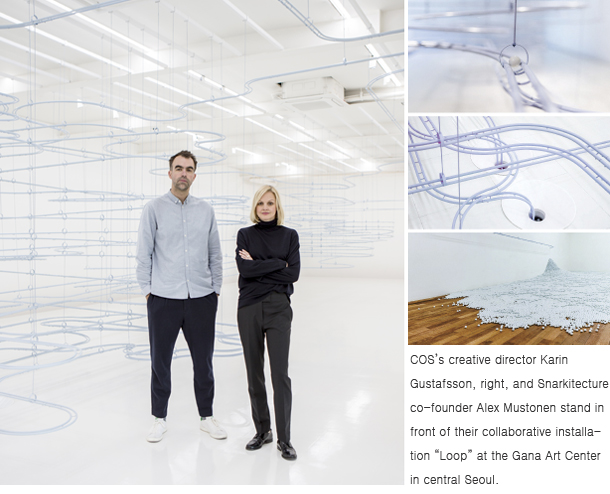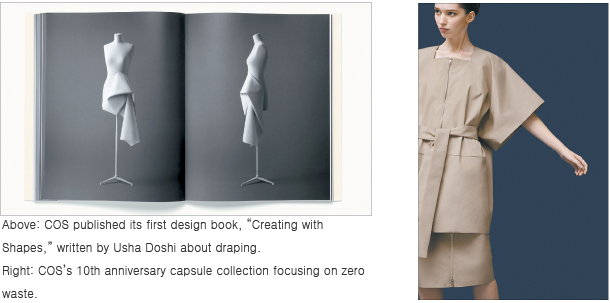A spreading sea of marbles shows fashion brand COS’s aesthetics : Collaboration with New York studio Snarkitecture is installed at the Gana Art Center in Seoul

[COS]
“I think we’re offering a collection that is almost like a blank canvas,” Gustafsson said. Even customers who like to wear colorful and flamboyant clothes can “play around” by mixing and matching items with COS’s simpler designs to create their own look.
Celebrating its 10th anniversary this year, COS has created something playful in Seoul in conjunction with an American studio called Snarkitecture. An installation entitled “Loop,” currently exhibited in the Gana Art Center in Pyeongchang-dong, central Seoul, is a collaboration between COS and Snarkitecture. The two companies insist they share a sensibility that is both playful and modern.
Based in New York, Snarkitecture was co-founded in 2008 by Daniel Arsham, who majored in art in college, and Alex Mustonen, who majored in architecture, to “investigate the boundaries between art and architecture.” According to Mustonen, who visited Seoul for the collaboration with COS, the “Loop” is a “conceptual and interactive installation that is based on childhood memory of marble games, and a visualization of COS and Snarkitecture’s shared value.”
“Loop” takes up two separate rooms. In the first, visitors are immersed in an all-white environment filled with hundreds of white glass marbles. After a while, you realize that a marble drops out of a hole in the wall every five seconds.
Where are they coming from?
The answer is in the next room, which is also all-white. Some 400 meters (0.25 miles) of rails are intricately interweaved. The marbles glide along them before disappearing into the next room. Mustonen says that the marbles and the rooms are colored white, while the rails have been powder coated in cold blue to express the colors of COS’s latest collection.
“Snarkitecture was established with a basic idea of making architecture perform the unexpected,” said Mustonen. “For example, we take things that we take for granted, or find things that are typical in architecture, and find imaginative ways to reinterpret them to create something new and unexpected.”

[COS]
“This enlarged version of a marble toy we used to play with as a child creates an array of uniquely kinetic moments, inviting visitors to explore, contemplate and reflect,” he says.
Visitors can play a role in “Loop” by picking up a glass marble from the first room and placing it on any point of the track in the next room. In that moment, the five-second rule gets disrupted, changing the form of the sea of marbles in the first room.
“Loop” is the third collaboration between COS and Snarkitecture. The first, in 2015, was for the Salone del Mobile furniture fair in Milan. According to Snarkitecture, the installation, which is a cavernous retreat comprised of thousands of thin white fabric sheets hanging at various lengths from the ceiling, attempts to reflect COS’s DNA - “an appreciation of clean lines, transparency and the transformation of the everyday.”
“COS, from the beginning, has been trying to find its inspiration from art and design,” explained Gustafsson. “Every time we create a collection, we look for colors and forms of art and design that would inspire us and collaborate with companies to create something together, whether it’s the look of the collection, a window display or an interior of stores.”
COS worked with Korean chair designer Mun Seungji in 2013.
“We saw Mun’s work, specifically his ‘Four Brothers’ chairs, and approached him instantly,” said Gustafsson. “We really liked the idea that four different looking chairs were made from a single sheet of plywood, maximizing the use of material and creating zero waste.”
COS displayed Mun’s four chairs in a window display at one of COS’s London stores and hung four different-looking white shirts that were also created with zero waste.
To share this value of creating zero waste yet still being classy, timeless, functional and tactile, COS recently published a design book, “Creating with Shapes,” written by Usha Doshi, who is teaching at London’s Royal College of Art and is a long-time collaborator with COS.
The book is about draping with shapes, a technique Doshi discovered by watching her grandchildren play with fabric. As the children cut out simple geometric shapes, Doshi discovered that these “shapes could be used to form intricate folds, drapes and pleats without using excessive fabric or complex darts and seams,” explained Gustafsson.
“Working with artists and designers who share similar values with us and focusing on creating modern, simple and eco-friendly yet playful designs have always been important for us.”
BY YIM SEUNG-HYE [sharon@joongang.co.kr]
도르륵 굴러오는 하얀 구슬, 어느새 바다
글로벌 패션 브랜드 코스(COS)는 군더더기 없는 심플함과 옷장 속에 꼭 갖춰 놓아야 하는 베이직한 디자인으로 유명하다. 하지만 코스의 크리에이티브 디렉터 카린 구스타브슨(Karin Gustafsson)은 “우리는 재미를 추구하는(playful) 소비자까지 포괄하는 브랜드”라고 강조한다. “코스의 옷들은 마치 하얀 캔버스와 같다. 화려한 옷을 좋아하는 소비자들이라면 심플한 디자인 위에 익사이팅한 아이템을 믹스매치 할 수 있다는 매력에 끌려 코스를 찾는다”는 것이 그의 자부심이다.
패션 브랜드 코스, 스나키텍처와 세 번째 예술 협업
올해로 10주년을 맞은 코스가 ‘재미를 추구하는’ 가치를 공유해온 사람들과 재미난 일을 벌였다. 실험적 디자인으로 유명한 스튜디오 스나키텍처(Snarkitecture)와 협업해 만든 설치 작품 ‘루프(Loop)’를 서울 평창동 가나아트센터에서 8일부터 16일까지 선보이는 것. 이를 위해 방한한 구스타프슨과 스나키텍처를 창립한 두 명 중 하나인 건축가 알렉스 무스토넨(Alex Mustonen)은 “두 회사가 공유하는 가치가 협업할 수 있는 원동력이 되어 즐거움이 더해졌다”고 입을 모았다.
뉴욕이 기반인 스나키텍처는 예술과 건축간의 경계를 넘나들기 위해 미술을 전공한 다니엘 아르샴(Daniel Arsham)과 건축을 전공한 무스토넨이 2008년 설립했다. 루프에 대해 “어릴 적 구슬 놀이를 연상케 하는 인터랙티브한 작품”이라며 “이것을 통해 코스와 스나키텍처의 공통 가치를 표현하고 싶었다”고 설명했다.
작품은 두 개의 방에 설치됐다. 첫 번째 전시실엔 새하얀 바닥과 벽면에 수천 개의 흰색 유리 구슬이 쌓여 있다. 가만히 보니 벽에 난 구멍을 통해 흰 구슬들이 끊임없이 굴러 떨어진다.
구슬들은 어디서 나오고 있는 것일까. 옆 방에 답이 있다. 연한 하늘색으로 파우더 코팅이 된 400m 짜리 알루미늄 레일은 뒤얽힌 모양새가 아찔한 롤러코스터 같다. 정교한 공학 기술 덕분에 구슬들은 충돌하지 않고 5초 간격으로 레일을 타고 내려와 첫 번째 방으로 낙하하듯 굴러간다.
무스토넨은 이렇게 설명했다. “관객들은 첫 번째 방에 들어서는 순간 새하얀 벽과 바닥 그리고 계속 굴러 떨어지는 구슬을 보면서 사색을 하게 될 것이다. 저 구슬들은 무엇이며 어떻게 이곳으로 오게 됐을까…두 번째 방에 가면 깨닫게 될 것인데, 관객들이 코스의 브랜드 가치와 감성이 어떻게 표현되었는지 경험하길 바란다”고 말했다.
관객들은 첫 번째 방에 쌓인 구슬을 주워다 옆 방 레일 위에 올려놓는 방법으로 작품에 동참할 수 있다. 무스토넨은 “그 순간 5초의 규칙은 흐트러지지만 첫 번째 방에 쌓여가는 구슬들의 형태는 변하게 된다”며 “‘새하얀 캔버스’ 같은 코스의 옷을 소비자가 원하는대로 마음껏 즐길 수 있다는 의미”라고 설명했다.
루프는 코스와 스나키텍처의 세 번째 협업 프로젝트다. 첫 협업은 2015년 밀라노 가구 박람회(Salone del Mobile)에서 선보였는데, 코스의 핵심 DNA인 간결한 선과 투명성의 모호함, 그리고 일상의 평범함을 특별한 것으로 바꾸는 것에 대한 찬사의 의미를 담아 반투명 동굴 작품을 만들었다. 구스타프슨은 “우리는 우리가 하는 디자인이 예술과 관련이 있다고 믿고 있다. 컬렉션을 선보일 때마다 형태와 색상의 영감을 아트와 디자인에서 찾고 있다. 우리와 가치가 비슷한 디자이너 및 아티스트들과 매장 인테리어, 윈도 디스플레이, 컬렉션 등 여러 ‘협업’을 해오고 있다”고 말했다.
한국 디자이너로는 2013년 의자 디자이너 문승지가 초대를 받았다. 그의 ‘포 브라더스 체어(Four brothers chair)’는 한 장의 나무 합판을 버리는 재료 없이 4개의 각기 다른 모양의 의자로 구현한 환경친화적 디자인이다. 자신들의 제로 웨이스트(원단 쓰레기를 최소화하기 위해 개발된 패턴) 디자인 철학을 잘 표현해 준다고 판단한 코스는 그의 의자들을 런던 매장의 쇼윈도에 비치했다.
올 가을엔 브랜드의 첫 디자인 서적도 출간했다. 코스 패턴 부문에서 오랫동안 프리랜서로 일해온 런던 왕립예술학교의 우샤 도시(Usha Doshi) 교수가 개발한 드레이핑 기법에 대한 것이다. 구스타프슨은 “10주년을 기념해 코스 또한 자투리를 최소화한 제로 웨이스트 캡슐 컬렉션을 선보였다”며 “예술을 기반으로 모던하고 심플하며 환경친화적이면서도 재미를 추구하는 고품질 컬렉션은 앞으로도 계속될 것”이라고 밝혔다.
글 임승혜 기자










with the Korea JoongAng Daily
To write comments, please log in to one of the accounts.
Standards Board Policy (0/250자)